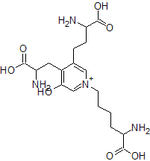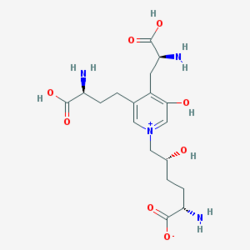Indicators of bone remodeling, markers of bone resorption
From WikiLectures
Markers of new bone tissue formation[edit | edit source]
Bone alkaline phosphatase (bALP)
- The Enzyme is part of the membranes of osteoblasts, it enters the blood during their increased activity (it must be distinguished from liver ALP).
Osteocalcin
- In addition to collagen, the main protein of bone tissue, it binds hydroxyapatite, its concentration in the blood rises slightly during new bone formation, but its molecule is very small, so it is quickly excreted by the kidneys (biological half-life is 4 minutes), its concentration also rises falsely in patients with renal insuficiency.
The carboxy-terminal propeptide of type I procollagen
- It is a fragment of procollagen I (C terminal propeptide), which is a precursor of collagen I (N terminal propeptide is very unstable, so it is not used), it has a large molecule, so its concentration is not affected by kidney function.
Markers of bone tissue resorption[edit | edit source]
Hydroxyproline
- one of the main amino acids of collagen, a very non-specific indicator, because in addition to collagen I of bones, it can also come from other types of collagen , ligaments , cartilage, food, etc., its concentration also depends on the function of the kidneys (hydroxyproline passes through the glomerulus, but is almost completely resorbed) and the liver (metabolize hydroxyproline),
- is determined in the urine in 24 hours.
Glycosides of hydroxylysine
- one of the main amino acids of collagen, it is secreted in the form of a glycoside, where the typical sugar component for bone is galactose (for ligament it is glucose, therefore hydroxylysine is a more specific marker than hydroxyproline).
The carboxy-terminal telopeptide of collagen I
- it is released from collagen I during bone resorption, but it has a fairly small molecule, which is why tartrate-resistant ALP is quickly excreted by the kidneys - ALP is thus distinguished from prostatic ALP, which is broken down by tartrate.
Pyridinoline amd deoxypyridinoline
- these are cross-links that connect collagen molecules to each other (post-translational modification), they are detected in urine (deoxypyridinoline is more specific because it is formed only from bone collagen, pyridinoline is also formed from cartilage collagen)
Links[edit | edit source]
References[edit | edit source]
- SCHNEIDERKA, Petr, et al. Kapitoly z klinické biochemie. 2. edition. Praha : Karolinum, 2004. ISBN 80-246-0678-X.




